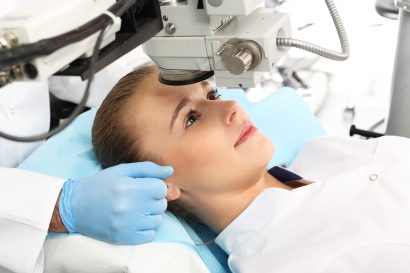SMILE vs. LASIK – What’s All the Flap About?
Written by Dr. David Evans Last modified on April 22, 2019
LASIK is the most popular refractive surgery currently performed in and outside the U.S., but there’s a new kid on the block that’s raising some eyebrows. Or should I say, giving people something to smile about. Small incision lenticule extraction (SMILE) is an all-laser refractive surgery procedure introduced in 2012 that is now being billed by some as a better option than LASIK.
A variation of FLEx surgery (Femtosecond lenticule extraction), SMILE has been performed widely in Europe for the last few years and just received FDA approval in September to be performed in the U.S. for nearsighted patients age 22 and older. Unlike LASIK surgery which requires creating a flap to expose the inner layers of the cornea, or PRK and LASEK which require the removal of the epithelial cells from the cornea, SMILE is a minimally invasive procedure that merely requires a tiny incision (approximately 2 – 4 mm) in the cornea through which to reshape the cornea.
LASIK, PRK and LASEK are popular procedures with exceptional success rates and low risk of complications, but initial data suggests that SMILE could be even better.

Due to the minimally invasive approach to surgery, treatment time can be reduced with SMILE, and patients are said to experience even less discomfort (which is already close to zero with LASIK), with better safety results and equally good visual results. The lack of a flap reduces the risk of dry eye following the procedure, which is a common side effect of LASIK surgery. (Check out our dry eye after LASIK article).
Currently, SMILE is being performed by more than 750 surgeons worldwide for patients with myopia (nearsightedness), but there is growing optimism that the procedure will have equally strong safety and efficacy results for hyperopia (farsightedness), presbyopia and keratoconus treatments. However the initial results for hyperopia have been mixed.
So what’s the downside to SMILE?
Well, aside from only offering proven treatment for myopia at this stage of evaluation, availability might be an issue. The procedure can only be performed using a specific type of laser called the VisuMax femtosecond laser from Zeiss. This means that if an ophthalmologist wants to start offering SMILE to patients, he/she would need to invest in another incredibly expensive piece of technology. Given that LASIK and related refractive surgery procedures already offer excellent visual outcomes with limited risk, many surgeons may be unwilling to make the additional investment. As a result, SMILE availability might be significantly more limited than LASIK and the like. At least for now. Due to SMILE’s success, a number of other companies are now developing lasers that can perform the procedure. And better yet, in some cases femto technology is being developed to perfrom both SMILE and LASIK with the same laser, which will give many more options to the surgeon and to patients without the necessary investment of multiple laser platforms. These developments should also help keep cost in check.
It’s also a relatively new procedure meaning that there have been no long-term studies of potential complications, such as the effects of incomplete lenticule removal. LASIK on the other hand has a long-proven track record. Also, there is limited data for patients who have had subsequent eye surgery, such as for cataracts, leaving little information about possible future complication rates. Although all indications are that cataract patients who have had SMILE will fare as well as their LASIK counterparts.
In the meantime, you can always check out our FLEx surgery article to learn more, or check out the SMILE treatment profile on the Zeiss website.



